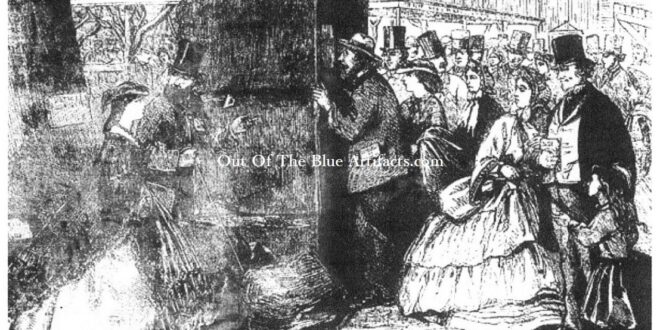The Living Frog Found in a Block of Coal at Tyr Nicholas, Cwmtillery Colliery.
This is a story from Monday 10th March 1862, when miners at Ty Nicholas Colliery the Cwmtillery Colliery, found a living frog in the coal seam below ground at the colliery.
Many newspapers throughout the country printed the story including the Pontypool Free Press, the Herts & Essex Observer and the Enniskillen Chronicle to name just a few. The former paper, printed on Saturday 29th of March 1862, stating that on the Monday 10th of March 1862, miners working 600 feet below ground in the rock vein coal seam discovered a small hole in the layer of coal, said to have been three and a half inches in diameter. Sealed inside the hole was a living frog, as soon as the creature was released from its dwelling it began to jump about. The miners kept the frog and sealed it in clay to keep the air from it. They alerted the manager of the mine Mr Lodowick William Rees who informed Mr John Russell, the owner of the colliery.
It was reported that “Mr John Russell the colliery owner, had the men carefully mine and remove the 8′ foot thick block of coal as he intends to put the frog back into its domicile and to have a viewing opening so people can see it living in its hole”. Mr Russell stated that he was to transport the lump of coal with the frog in it, to the coming International Exhibition of 1862, where it will be on display”.
The International Exhibition of 1862.
The main (featured image above) is an old print of the frog being viewed at the International Exhibition that was held between the 1st of May to the 1st of November 1862, at South Kensington, London. The site of the International Exhibition is now occupied by the National History Museum and the Science Museum.
Her Majesty’s Ships.
It was also reported that many people may have thought this “Living Frog” story to be a publicity stunt, though in reality, during 1859, Mr John Russell had his coal at the Tyr Nicholas Colliery tested by the government and it was stated that it was the best quality steam coal in South Wales and most sought after. After this testing procedure he was granted a large lucrative contract to supply Her Majesty’s Ships, so Mr Russell had no reason or interest to gain publicity in this way?
The Living Frog Phenomena.
While researching the living frog story at Cwmtillery, many other frog stories cropped up in the national newspapers, following are just a few reports similar to that of the Cwmtillery frog, before and after the Cwmtillery discovery.
Duke of Hamilton Colliery.
On Sunday 19th of October 1845, the Weekly Chronicle (London) reported that at the Duke of Hamilton Colliery at Wallacetown, Falkirk, a living frog was found embedded in a lump of coal 42 fathoms below ground, 300 yards from the bottom of the shaft. Seven miners had seen the frog and they said it did not have a mouth though it had large brilliant eyes.
Abergavenny, Monmouthshire.
In 1847, the Newcastle Journal reported that a stone mason at Abergavenny, Monmouthshire found a living frog in a block of freestone, three feet from any fissure present in the stone.
Bathgate, Linlithgowshire.
On Sunday 29th of October 1846, the Weekly Chronicle (London) reported that colliers working in a pit at Bathgate, Linlithgowshire were astonished, on breaking a large piece of coal, to see a frog jump out. It was said that the niche was smooth, the same shape as the frog but without a crack or crevice to give it air.
Gartlee Coal Pit.
On Tuesday 1st of August 1848, the Glasgow Courier reported at Gartlee Coal Pit near Airdrie, a frog was found below ground in a ball of clay. It was taken to Andersonian Museum to be put on view.
Dundonald Colliery.
On Saturday 16th of January 1858, the Salisbury & Winchester Journal reported on the recent discovery of a living frog found in solid rock at Dundonald Colliery, Fife. The creature was found 90 yards below ground in layers of coal, freestone and ironstone.
Heatheryknowe Colliery.
On Wednesday 15th of February 1882, the Dundee Evening Telegraph reported that Messrs James Macnaughton, son and Co of the Heatheryknowe Colliery stated a worker discovered a living frog during the course of his operations at 84 fathoms below the surface in the Kiltongue coal seam. The creature lived for only an hour after being released.
The Llanhilleth Frog.
In May 1893, a gang of workmen working under the superintendence of the contractor Mr H. Gross excavating stone from a quarry in Llanhilleth came across a frog in a hole in a rock in the same conditions, though the “Llanhilleth Frog” didn’t have a mouth even though it was fully developed. As it was released from its hole in the rock it was in a stupor and remained like that for a few days, though within a week it became lively and was jumping about.
 Out Of The Blue Artifacts A Library of a lifetime of collecting
Out Of The Blue Artifacts A Library of a lifetime of collecting
